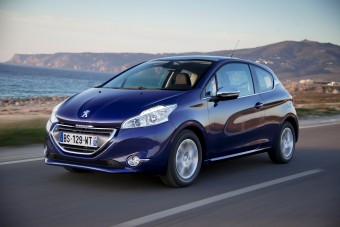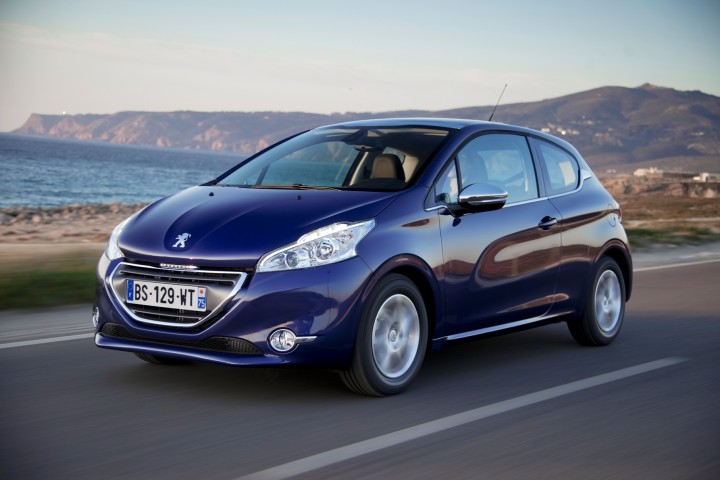 Less weight, less money, more engine options, more fuel economy, more interior space and potentially more desirability should bring more sales for the new Peugeot 208 which replaces the 207 hatchbacks.
Less weight, less money, more engine options, more fuel economy, more interior space and potentially more desirability should bring more sales for the new Peugeot 208 which replaces the 207 hatchbacks.
The new 208 range of three and five door supermini sized hatchbacks go on sale in the UK on 28 June 2012. The new three cylinder 1.0/1.2-litre indirect injection petrol engine models will arrive in late summer.
An average 114kg has been carved off the weight of the previous 207 hatchback models for the new 208 hatchback range which uses much of the 207’s construction architecture.
Due to bumper reprofiling the 208’s length is reduced by 70mm and inside the car has more occupant space due to new seat design with 50mm more knee-room in the rear and a shade more boot space.
A smaller diameter steering wheel is now used and the instrument panel is now viewed over the wheel, not through it. This weight saving and the addition of new or revised engines reduces CO2 emission by an average of 34g/km over those of the 207. Lower CO2 figures mean less tax costs and better fuel economy.
Diesel engines of 1.4/1.6-litre with power outputs of 68 to 115bhp have CO2 emissions ranging from 87 to 99g/km with 83.1 to 74.3mpg. Petrol units with capacities of 1.0/1.2/1.4/1.6-litres range from 68 to 156bhp with CO2 emissions of 99 to 135g/km with fuel economy figure ranging from 65.7mpg down to 48.7mpg.
Prices for the UK will be on average £150 less per unit across the range and with around £500 added value specification in terms of new engine technology, trim and equipment levels compared to the 207 hatchback models said Mark Blundell, Peugeot’s UK product and planning manager. UK prices will start at £9,995 and rise through a wide selection of models to £17,495.
The new 208 range will initially be available as hatchbacks and Peugeot said that other versions will follow. As for the UK market the product and planning manager Mark Blundell added that the problem the 207 had caused them had been their inability to provide smaller petrol engine options, lower cost units and therefore cheaper to run. With the introduction of the new 1.0 and 1.2-litre three cylinder petrol engines this issue has been overcome.
He said the 207 was still their largest selling model range in the UK regularly achieving 30,000 sales a year but the new 208 has a sales target of 37,000 units in a full year. He anticipates that the 1.2-litre and 1.4-litre petrol engines will become the 208’s most popular engine choices and the five door models will take around 75 per cent of sales.
In the UK retail buyers have taken up 62 per cent of 207 sales and petrol models have accounted for 74 per cent of registrations. With the price advantage petrol fuel has over diesel Blundell said he expects the petrol powered 208 models to improve on those figures although fleet and business users will be attracted by the revised and lower CO2 emission diesel engines, most fitted with their e-HDi micro hybrid stop/start function.
The 208 has five levels of specification, Access, Access+, the best selling Active, followed by Allure and the small selling Feline level which will appeal to around 3.0 per cent of UK customers.
First impressions
The launch of the new Peugeot 208 B segment supermini with three and five door body styles is the most important new Peugeot to be introduced this year and in any year in their regeneration strategy and sales begin on 28 June. The keynote point about the 208 is the reduction in weight over the 207 hatchbacks.
Weight-saving in all areas from the drivetrain to the body construction has resulted in 114kg being carved out of the vehicle. The 208 actually uses the same platform and construction architecture as the 207 but it has been revised from nose to tail, inside and out. The overall length has been marginally reduced so it looks more compact and hence visually easier to park.
The front and rear bumpers have been slimmed down so the 208 looks less heavy and bulbous. The weight loss means it is more agile on the road so that improves performance, reduces CO2 emissions and improves fuel economy.
The styling changes have got rid of the overpowering droopy nose bonnet design of the previous 207 and a new and more refined grille is more subtle. The sides of the body are more curvaceous so the car looks more athletic and less ponderous. There is signature LED lighting used front and rear to complete the modern exterior styling package.
Inside there is more passenger space, especially knee room in the rear, and the boot is marginally larger. Much of this has been done by the re-shaping of the seats.
Another innovation is the use of a smaller diameter steering wheel which gives the driver more room and this layout is used in conjunction with moving the instrument panel higher on the dashboard so the dials are read over the steering wheel, not through it.
It takes a little time to adjust to this layout but it works. Most models gain a 7-inch touchscreen mounted almost in a freestanding or ‘floating’ way from the centre of the console. This screen is used to access various functions: radio. Bluetooth, sound system and the on-board computer and where fitted the navigation system.
This unit will also be used to accommodate a huge range of App information applications covering traffic conditions, fuel stations and fuel prices, parking spaces, the Michelin Guide of restaurants and hotels, weather and even Yellow Pages. When launched this paid for system will operate 24/7 covering 17 countries.
The need to appeal to more customers with a wider range of even more fuel efficient engines is an important element in Peugeot’s regeneration programme for the brand and their 207 replacement. The efficiency of the HDi diesel engines and the VTi and THP petrol engines has been reinforced by the arrival of a new generation of three cylinder petrol engines. These changes and additions contribute to the reduction of 34g/km in the average CO2 emissions of the 208 range compared with the 207. The comprehensive engine line up has the following diesel units at launch: 1.4 and 1.6-litre turbo units with power outputs from 68 to 92 and then to 115bhp. Most use Peugeot’s e-HDi micro-hybrid Stop and Start system. CO2 emissions start at a low 87g/km and rise only to 99g/km. Fuel economy ranges from 74.3 to 83.1mpg.
With diesel engine sales in this sector relatively small, because of the higher price of the engine and fuel over petrol units, around 26 per cent of 208s will be diesel powered in the UK, mainly to fleets and businesses. Much more important for 74 per cent of UK buyers will be the new petrol engine line-up especially for those customers who didn’t buy a 207 because there wasn’t a low CO2, high fuel economy unit on offer.
The headline now is that two, three cylinder petrol engines have been added to the range. One is a 1.0-litre 68bhp/95Nm unit with a five-speed gearbox with CO2 emissions of 99g/km and with a 65.7mpg Combined Cycle figure. The more popular three cylinder unit will be the 1.2-litre unit with 82bhp/118Nm with 104g/km of CO2 and returning 62.8mpg.
Next in the line-up is the 1.4-litre four cylinder 95bhp136Nm unit with 129g/km and returning 50.4mpg. This is followed by the 1.6-litre 120bhp/160Nm 134g/km, 48.7mpg engine and finally there will be the 1.6-litre turbocharged THP 156bhp/260Nm 135g/km and 48.7mpg unit.
The three cylinder petrol engines and the 1.6 THP units will be available for the UK market later this summer. Peugeot expects in the UK new three cylinder engines to take 40 per cent of 208 sales but the single best selling model is likely to be the 1.4-litre four cylinder petrol 95bhp unit with the Active trim and equipment level and the five door version will cost around £13,295.
A three door version will be around £600 less. On the international test drive, most evident was the more amenable styling inside and out and I liked the new smaller steering wheel, raised instrument panel design a lot.
The car benefits most from the weight loss over the 207 hatchbacks. It has come to life, it is agile, the handling is more predictable and the steering responses sharper and less ponderous. The suspension absorbs most bumps and potholes without any great loss in ride comfort and the best performance in that department came from the standard 15-inch wheels for the Active specification level rather than the higher spec versions with 16-inch rims.
The Active level also has most items of equipment needed and I can see why that will be most popular for most people. I tried a variety of the engines on offer but the 1.4-litre 95bhp four cylinder petrol unit impressed me most because of its extra torque.
I think it is worth paying the extra £500 over the next best selling new 1.2-litre, three cylinder, 82bhp petrol unit. Both could do with having a smoother action six speed manual gearbox rather than the current five-speeder which would reduce engine revs at higher cruising speeds and I suspect further improve fuel economy.
That said the 1.2-litre three cylinder unit is a bright and lively engine and a worthwhile addition to the range. It will suit users who mainly cover short trips and the occasional longer motorway journey. For the record over the same test route the 1.2-litre unit recorded 38.2mpg, the four cylinder 1.4 unit returned 41.3mpg as it had to work less hard up hills and during acceleration.
The much more agile, sharper looking, roomier and better looking 208 benefits from all the changes and in particular the weight being taken out of the car. That will be a huge weight off the shoulders of Peugeot who should see a significant increase in sales for the 208 over the ponderous 207. The new three cylinder petrol engines will do their part in regenerating sales for some people as well so it looks like a win-win situation.
MILESTONES
Peugeot 208 1.4 VTi 95bhp, Active, 5-Door. (Best selling model). Price: £13,295 (tbc) Engine/transmission: 1.4-litre, four cylinder, 95bhp, 136Nm (100lb ft) of torque at 4,000rpm, 5-speed manual Performance: 117mph, 0-62mph 10.5 seconds, Combined Cycle 50.4mpg (41.3mpg on test) CO2 129g/km, VED road tax £0 First Year rate then £100 second year onwards, BIK company car tax 16%. Insurance group: 12E. Dimensions/capacities: L 3,965mm, W 1,829mm, H 1,460, boot/load space 285 to 1,076-litres.
For: Better in all areas than the 207 hatchback it replaces, agile, lighter weight, sharp handling, wide range of engine options, a quality interior, better rear seat knee room.
Against: Thick front quarter pillars limit visibility, worst of the potholes will be felt in the cabin.

